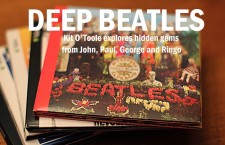One of the least-known tracks off the Beatles’ Help! soundtrack, “Tell Me What You See” has even been dismissed by its chief songwriter: Paul McCartney. “Not awfully memorable. Not one of the better songs but they did a job, they were handy for albums or b-sides,” he told biographer Barry Miles. Is the song worthy of such a lukewarm review? While relatively obscure to casual fans, its variety of instrumentation and unusual structure further demonstrate the Beatles’ growing experimentation and determination to expand the pop/rock landscape.
In Miles’ Many Years from Now, Paul McCartney vaguely recalled that he composed the majority of the track, but that John Lennon may have assisted. Lennon claimed in his 1980 Playboy interview that McCartney alone wrote “Tell Me What You See.” They presented the song to director Richard Lester for inclusion in the Help! film, but Lester passed on the tune. It did eventually find a home on the soundtrack album and, in the U.S., on Beatles VI.
The Beatles recorded the song at Abbey Road on February 18, 1965. Under the direction of producer George Martin and engineer Norman Smith, the band laid down three tracks during the marathon session: “Tell Me What You See,” “You’ve Got to Hide Your Love Away,” and the unreleased “If You’ve Got Trouble” (it finally surfaced on the Anthology 2 compilation).
Recorded in four takes, “Tell Me What You See” features McCartney on vocals, bass, and electric piano; Lennon on vocals, rhythm guitar, and tambourine; Ringo Starr on drums and claves; and George Harrison on güiro, a Latin-American percussion instrument consisting of a hollow gourd with horizontal notches cut into one side. The musician rubs a stick along the notches to produce a unique sound. Another key instrument is the Hohner Pianet electric piano, played after the refrain. Note how the song’s tone and mood change with the piano removed from the mix:
Paul McCartney may not have considered “Tell Me What You See” “memorable,” but it marks important stages in the Beatles’ artistic development.
First, percussion takes a central role on the song, with three different instruments used. Ringo Starr also demonstrates his ability to play different tempos and styles during one track; twice he breaks out of the dominant tempo to perform a riff that varies from the previous rhythm. After Lennon and McCartney harmonize on the title phrase, McCartney plays the electric piano, followed by a slightly offbeat, lumbering fill slightly reminiscent of “What You’re Doing” from Beatles for Sale. The claves and güiro remain high in the mix, propelling the rest of the song.
Second, “Tell Me What You See” foreshadows the acoustic sound of Rubber Soul, released in December 1965. Compare the song with “You Won’t See Me” — the harmonies, prominent percussion, piano, and introspective lyrics resemble the preceding tune, illustrating how the Beatles were progressing toward a folkier sound as early as February 1965. The electric piano solo may have been inspired by previous singles such as the Zombies’ 1964 hit “She’s Not There,” a track that prominently featured the instrument to lend a haunting air to the tune.
Finally, the melancholy yet playful lyrics demonstrate just how much Paul McCartney had grown as a lyricist. Lines such as “We will never be apart if I’m part of you” shows a willingness to experiment with language, similar to songwriting partner John Lennon’s methods.
His constant references to vision communicate the narrator’s attempts to convince his lover that he will stand by her. She may close her eyes and he seemingly disappears, as she apparently expects. But when the protagonist commands her to “open up your eyes now, tell me what you see,” he prompts her to admit that he still stands before her. The sky may darken, but his love and loyalty will brighten her world (yet another reference to vision. In other words, his love will lift the metaphorical darkness and help her see the world through different, positive lenses). He would use a similar technique in Rubber Soul’s “I’m Looking through You,” in that case using vision to express deceit.
Unusual instrumentation, a preview of the Beatles’ folkier sound, and increasingly sophisticated lyrics: all of these elements earn “Tell Me What You See” more attention. It marks a significant phase in their history, which renders the song anything but forgettable.
- The Rescued Early Paul McCartney Song That Completed ‘Beatles For Sale’ - December 4, 2024
- A Rare Beatles Cover Proves John Lennon Was Wrong About His Voice - November 26, 2024
- How John Lennon Came Roaring Back on the Beatles’ White Album - November 22, 2023



All of these Deep Beatles’ articles are detailed, well-critqued and make a particular point about some of the band’s lesser known works. Keep up the great work, Kit!
Thank you so much–that’s very kind of you! I thoroughly enjoy writing these columns, particularly since I always learn something new about songs I thought I knew inside out.
It’s one of my favorite tunes by the Beatles. The vocal parts in fifths remind me of Buddy Holly, actually. By the way, this is a revealing analysis, enjoyable to read.
Thank you very much, Ken, I’m glad you enjoyed it.
Fantastic article!
Great Article, Very Insightful
Thanks for the kind comments, A.L. and landsart!
I actually like it more than ywsm, mainly because i think ywsm is just too long. In any case, great article
I like it better without the electric piano. Great piece.
Thank you all for your comments! Glad you enjoyed the article–I had fun working on it.